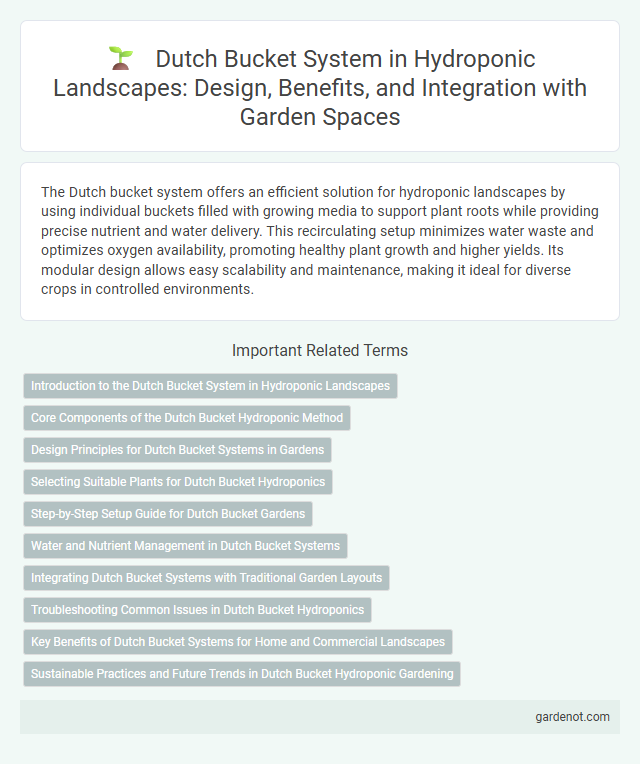The Dutch bucket system offers an efficient solution for hydroponic landscapes by using individual buckets filled with growing media to support plant roots while providing precise nutrient and water delivery. This recirculating setup minimizes water waste and optimizes oxygen availability, promoting healthy plant growth and higher yields. Its modular design allows easy scalability and maintenance, making it ideal for diverse crops in controlled environments.
Introduction to the Dutch Bucket System in Hydroponic Landscapes
The Dutch Bucket System is a popular hydroponic technique used in landscapes to efficiently grow vine crops like tomatoes, cucumbers, and peppers. Each bucket acts as an individual growing container with a drainage system that recirculates nutrient-rich water, optimizing resource use and promoting healthy root development. This system supports high-density planting and is valued for its simplicity, scalability, and water conservation in controlled environment agriculture.
Core Components of the Dutch Bucket Hydroponic Method
The Dutch bucket hydroponic method relies on core components including durable buckets with drainage holes, a water reservoir, and a nutrient delivery system comprising pumps and drip emitters. Each bucket contains a growing medium such as coconut coir or perlite to support plant roots while ensuring proper aeration and moisture retention. An efficient drainage system channels excess nutrient solution back to the reservoir for recirculation, optimizing water and nutrient use in hydroponic crop production.
Design Principles for Dutch Bucket Systems in Gardens
Dutch bucket systems in gardens utilize a modular design with individual buckets connected by a reservoir and recirculating water pump, ensuring efficient nutrient delivery and water conservation. Each bucket typically contains a growing medium such as perlite or coconut coir for optimal root aeration and drainage, supporting healthy plant growth. Proper spacing and alignment of buckets promote airflow and light exposure, enhancing crop yield and minimizing disease risk in hydroponic landscapes.
Selecting Suitable Plants for Dutch Bucket Hydroponics
Selecting suitable plants for Dutch bucket hydroponics involves choosing those with moderate to large root systems and a preference for drip irrigation, such as tomatoes, peppers, cucumbers, and eggplants. These crops thrive in the aerated, well-draining environment of Dutch buckets, which prevent root rot and maximize nutrient uptake. Opting for varieties with manageable vine growth enhances system efficiency and supports sustainable, high-yield production.
Step-by-Step Setup Guide for Dutch Bucket Gardens
The Dutch bucket system uses individual containers filled with growing media like perlite or coconut coir, each connected to a recirculating nutrient solution supply. Begin by setting up a sturdy frame or bench to hold the buckets, install the irrigation tubing with emitters directed into each bucket, and place a drainage tube on each to return excess runoff to a central reservoir. Ensure the reservoir is filled with a balanced hydroponic nutrient solution, adjust the water pH between 5.5 and 6.5, and install an air pump or oxygenator to maintain optimal root oxygen levels.
Water and Nutrient Management in Dutch Bucket Systems
The Dutch bucket system efficiently manages water and nutrients by delivering a precise volume of nutrient solution directly to each plant's root zone, minimizing waste and promoting optimal growth. Recirculating nutrient solutions through a closed-loop system conserves water, reduces runoff, and maintains consistent nutrient concentrations for uniform plant development. Automated monitoring and adjustment of pH and electrical conductivity ensure that plants receive balanced nutrition, enhancing both yield and resource sustainability in hydroponic landscapes.
Integrating Dutch Bucket Systems with Traditional Garden Layouts
Integrating Dutch bucket systems with traditional garden layouts enhances water efficiency and space utilization, allowing for precise nutrient delivery to crops like tomatoes and peppers. This hybrid approach supports diverse plant selections by combining soil-based cultivation with hydroponic container setups, promoting healthier growth cycles and higher yields. Leveraging modular Dutch buckets within established garden designs also simplifies maintenance and pest management, optimizing overall landscape productivity.
Troubleshooting Common Issues in Dutch Bucket Hydroponics
Dutch bucket hydroponics often encounters issues such as clogging in the drip emitters, typically caused by nutrient precipitates or algae buildup, which can be resolved by regular flushing and filtration system maintenance. Nutrient imbalances frequently lead to leaf discoloration and stunted growth, necessitating precise monitoring of pH levels and electrical conductivity to ensure optimal nutrient uptake. Root rot, a common problem caused by stagnant water or poor aeration, requires improved oxygenation through air stones or adjusting the recirculation pump to maintain healthy root systems.
Key Benefits of Dutch Bucket Systems for Home and Commercial Landscapes
Dutch bucket systems offer precise water and nutrient control, minimizing waste and promoting healthier plant growth in hydroponic landscapes. Their modular design supports diverse crops, making them ideal for both home gardens and commercial operations seeking scalability. Efficient space utilization and reduced pest exposure further enhance crop yield and quality in these controlled environments.
Sustainable Practices and Future Trends in Dutch Bucket Hydroponic Gardening
The Dutch bucket system prioritizes sustainable practices by maximizing water efficiency through recirculation and minimizing nutrient runoff, reducing environmental impact in hydroponic gardening. Integration of renewable energy sources like solar-powered pumps enhances energy sustainability, while automation technologies optimize nutrient delivery and plant growth. Future trends indicate advancements in biodegradable substrates and smart monitoring systems to further improve resource use and crop yields in Dutch bucket hydroponics.
Dutch bucket system Infographic

 gardenot.com
gardenot.com